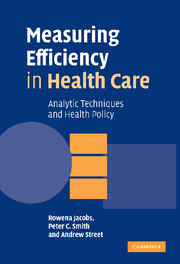Book contents
- Frontmatter
- Contents
- List of figures
- List of tables
- Preface
- Acknowledgements
- List of abbreviations
- 1 Efficiency in health care
- 2 The components of an efficiency model
- 3 Stochastic frontier analysis of cross-sectional data
- 4 Stochastic frontier analysis of panel data
- 5 Data envelopment analysis
- 6 The Malmquist index
- 7 A comparison of SFA and DEA
- 8 Unresolved issues and challenges in efficiency measurement
- 9 Some alternative approaches to measuring performance
- 10 Conclusions
- Appendix: Data description
- References
- Author index
- Subject index
8 - Unresolved issues and challenges in efficiency measurement
Published online by Cambridge University Press: 10 December 2009
- Frontmatter
- Contents
- List of figures
- List of tables
- Preface
- Acknowledgements
- List of abbreviations
- 1 Efficiency in health care
- 2 The components of an efficiency model
- 3 Stochastic frontier analysis of cross-sectional data
- 4 Stochastic frontier analysis of panel data
- 5 Data envelopment analysis
- 6 The Malmquist index
- 7 A comparison of SFA and DEA
- 8 Unresolved issues and challenges in efficiency measurement
- 9 Some alternative approaches to measuring performance
- 10 Conclusions
- Appendix: Data description
- References
- Author index
- Subject index
Summary
Introduction
In this chapter we discuss four of the most important issues that arise when seeking to use efficiency models in the health care sector: the weights used to indicate the values of different outputs; how the efficiency models are constructed; the treatment of environmental influences on performance; and dynamic aspects of efficiency.
Output weights
There are important questions relating to the objectives encompassed by any index of efficiency, particularly when the analysis is to be used for regulatory purposes. Is it legitimate for the central policy maker to attach a uniform set of objectives to all organisations? If so, is it further legitimate to apply a uniform set of weights to these objectives? If so, how should they be chosen? If not, what is the extent of legitimate variation, and who should choose? These are fundamental issues, the answers to which determine whether or not creating a single measure of organisational performance is warranted. In our view, organisations can be ranked on efficiency only if the policy maker may legitimately (i) set objectives and (ii) attach weights to those objectives.
When comparing organizations that are charged with meeting social objectives, the set of output weights ought to reflect societal values. However, it is not a simple matter to derive such weights, particularly when organisations face multiple objectives and there is disagreement as to organisational priorities. Ultimately the selection of objectives in the public services is a job for the politicians charged with reconciling conflicting claims on public resources.
Information
- Type
- Chapter
- Information
- Measuring Efficiency in Health CareAnalytic Techniques and Health Policy, pp. 167 - 178Publisher: Cambridge University PressPrint publication year: 2006
